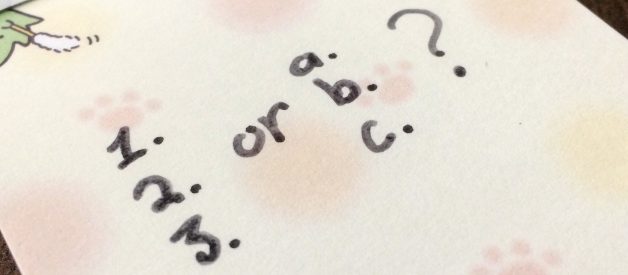
What exactly are the formal rules for writing a list of items in English? There are so many ways to do it and so many opinions on which is best! One thing is for sure: if you are going to explain something, there?s a good chance you will have to use a list, so figure it all out on the double with this article!
Simple Horizontal Lists
A horizontal list is one that you write as part of a larger sentence. For example, if I told you I have a cat, a dog, and a bird as pets, I just created a list within the natural flow of the sentence.
If you are listing simple items, as above, separate each item with a comma. You should use ?and? or ?or? just before the last item to indicate the conclusion of the list. ?And? is inclusive and means all of the items mentioned apply, whereas ?or? indicates that only one of the items is relevant. In informal situations, you could also write ?and/or? if it is unclear whether just one or some combination of the items should be indicated.
I checked out a book, a movie, and a CD from the library.The librarian told me I can check out a book, a movie, or a CD.
In the first sentence, the speaker took all three items. In the second, the speaker has been told they must pick one.
Notice that in the examples above, I included a comma before the last ?and? or ?or?. This is known as the oxford comma or the serial comma. It is often used in English but is a point of disagreement among writers. Some people claim it makes the sentence more confusing, and some claim just the opposite, saying it?s necessary for clarity. The truth is you can use or omit the final comma as long as you are consistent throughout your work.
Horizontal Lists with Semicolons
If you need to list complex items, for example, particularly long phrases or phrases that include commas already, you can use semicolons to punctuate your list.
On his trip, Waldo visited Austin, Texas; Atlanta, Georgia; and Juneau, Alaska.
The items above are cities and states. The name of the state is always offset with commas when paired with a city as above, but consider what happens if we used commas to break the list also:
On his trip, Waldo visited Austin, Texas, Atlanta, Georgia, and Juneau, Alaska.
If you were even just a bit unfamiliar with American geography, how would you have any idea whether these are all cities, states, or pairs? The sentence becomes much less clear because commas are used both within items and to distinguish between items.
Another time you may need to use semicolons in a list is when you have long phrases acting as items.
If you want to travel internationally you can go by plane, which is the fastest option; by train, if the countries you want to visit are connected by land; or by boat, if the countries are separated by a body of water.
Again, the semicolons provide a more obvious break between list items, creating clarity. Here?s the comma version:
If you want to travel internationally you can go by plane, which is the fastest option, by train, if the countries you want to visit are connected by land, or by boat, if the countries are separated by a body of water.
It becomes very unclear which of the phrases broken by commas indicates an item on the list versus a description of one of the types of transportation. The sentence seems very long and may easily confuse the reader.
Notice, however, that if you really really didn?t want to use semicolons, you could also create clarity by replacing the commas in the list items with parentheses.
If you want to travel internationally you can go by plane (which is the fastest option), by train (if the countries you want to visit are connected by land), or by boat (if the countries are separated by a body of water).
Since different forms of punctation are used, it is once again easy for the reader to tell where a list item begins and ends. This formatting is grammatically valid, so the choice is yours!
Vertical Lists
If you want to set your list apart from the surrounding text, you can use a vertical list. This includes bulleted or sequenced lists (using numbers, letters, or any other ordinal).
If the order doesn?t matter, go with a bulleted list.If you need to talk about specific items later, use letters.If the order is important, use numbers.
First, for any of these types, you should introduce the list in the preceding text. Technically, you can use a complete sentence or a fragment before a vertical list, but I recommend a complete sentence.
If you introduce a vertical list with a complete sentence, place a colon (:) at the end of the intro sentence. However, if you introduce a vertical list with a fragment, use no punctuation at all before starting the list.
For example, these are popular genres of music:
- Pop
- Rock
- Oldies
- Country
You can continue your text normally after finishing a the list, like I?m doing now. I can demonstrate using a fragment to introduce a list by saying that, besides music, popular media includes
a. Movies
b. Plays
c. Books
Once again, however, I don?t recommend using a fragment. If the list items complete your intro sentence, then it might be better to list them horizontally, as part of the sentence. The list above also uses letters to distinguish items, which would be useful if I wanted to tell you that (a) tends to be more popular than (b). I can reference the list without re-writing each whole list item, which could be useful if the items were long phrases.
Also, above, I have capitalized each item in my lists. Capitalizing the first letter helps the list to look intentional, but it is not grammatically necessary. As long as you are consistent, you can choose whether or not to capitalize the items in your list.
Another important detail is end punctuation for the list items. Above, no end punctuation has been used, because the items are not complete sentences. If your list items are simple noun phrases or sentence fragments, do not use end punctuation ? no periods, no commas, no semicolons. If your list items are complete sentences, then you can grammatically end them with a period as a stylistic choice. Never place commas or semicolons on the end of the items in a vertical list, and do not write ?and? or ?or? before the last list item. Here is a list with complete sentences for list items:
- Get out the peanut butter and jelly.
- Place two slices of toast on your plate.
- Spread the peanut butter on one slice and the jelly on another.
- Smush them together!
- Eat.
Similarly, if you have decided to write a vertical list where each item offers a possible conclusion to the introductory fragment, then you may wish to use end punctuation. Imagine that the introductory fragment should be placed before each list item in the mind of the reader, constructing a different complete sentence for each item. For example, before you write, you should
- Check the rules.
- Research your topic.
- Make an outline.
These items complete the introductory fragment (though incidentally they could be complete sentences on their own as well), so end punctuation is acceptable in this special case.
You could imagine putting the pieces together like this: 1. Before you write, you should check the rules; 2. Before you write, you should research your topic; and 3. Before you write, you should make an outline. In this way, the introductory fragment is completed by the list fragments.
Which do I choose?
When making a list, the most important thing is to express your ideas with clarity. As long as this is achieved, the other choices are stylistic.
You can capitalize as you choose, and, in some cases, you can apply end punctuation as you choose. No matter what you decide, you must be consistent. Once you set a standard for your paper, follow it for each list you write.
Also note that it is important for the items in a list to be parallel. If each item is a simple noun, there should not be a sudden verb in the list. Likewise, if the items are all in the past tense, then there should not suddenly be a present or future tense item. Make sure that your list items match so that your writing follows the rules of parallelism.
Did you find this helpful? Check us out at www.Ediket.com! Ediket is an online proofreading / copy editing platform that connects qualified English editors to people who need help with their writing. You write, we complete!
Ediket only costs $5 per page and takes around 30 minutes, so your writing can be perfect, even on a budget or with a deadline.

